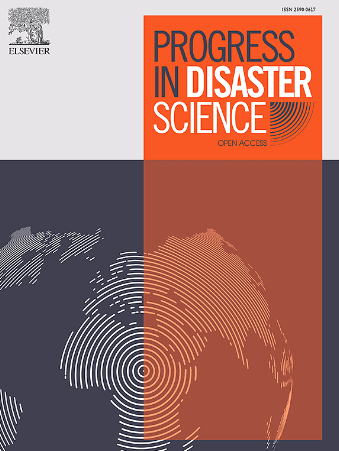Improving the assessment of volcanic risk from in-situ vulnerability studies: A methodological approach through the case study of the Ollagüe volcano, northern Chile
IF 3.8
Q3 ENVIRONMENTAL SCIENCES
引用次数: 0
Abstract
Volcanological studies in the Central Volcanic Zone of the Andes (CVZA) started in the 1970s and 80s. However, research on volcanic risk only increased over recent years. Specifically, in the volcanoes of northern Chile, few extant studies have focused on compiling the limited hazard and vulnerability data available from small villages located nearby. Risk assessment strategies considering vulnerability analysis have primarily focused on the physical components, whereas few works have considered vulnerability in its social, territorial, and economic dimensions. To evaluate risk dimensions around the Ollagüe volcano (Antofagasta, Chile), we integrate the analysis of elements at risk, that is, the semi-quantitative and qualitative vulnerabilities of Ollagüe, Amincha, Quebrada del Inca, and Coska villages, to volcanic hazards. The findings provide a comprehensive view of volcanic risk through the creation of several thematic volcanic risk maps, for example, extremely low social and physical risk pertains to Amincha, Coska, and Quebrada del Inca villages, whereas moderate social and low physical risk pertains to Ollagüe village. This study and the maps obtained could be extremely useful and potentially used by government institutions in charge of developing emergency and evacuation plans for disasters.
通过现场脆弱性研究改进火山风险评估:以智利北部ollag火山为例的方法学方法研究
安第斯山脉中央火山带(CVZA)的火山学研究始于20世纪70年代和80年代。然而,对火山风险的研究近年来才有所增加。具体地说,在智利北部的火山中,很少有现存的研究集中于汇编附近小村庄提供的有限的危险和脆弱性数据。考虑脆弱性分析的风险评估策略主要集中在物理组成部分,而很少有工作从社会、领土和经济维度考虑脆弱性。为了评估ollag火山(智利安托法加斯塔)周围的风险维度,我们整合了风险要素的分析,即ollag、Amincha、Quebrada del Inca和Coska村庄对火山灾害的半定量和定性脆弱性。研究结果通过创建几个主题火山风险地图,提供了火山风险的综合视图,例如,Amincha, Coska和Quebrada del Inca村的社会和物理风险极低,而ollag村的社会和物理风险中等。这项研究和获得的地图可能非常有用,并可能被负责制定灾害应急和疏散计划的政府机构使用。
本文章由计算机程序翻译,如有差异,请以英文原文为准。
求助全文
约1分钟内获得全文
求助全文
来源期刊

Progress in Disaster Science
Social Sciences-Safety Research
CiteScore
14.60
自引率
3.20%
发文量
51
审稿时长
12 weeks
期刊介绍:
Progress in Disaster Science is a Gold Open Access journal focusing on integrating research and policy in disaster research, and publishes original research papers and invited viewpoint articles on disaster risk reduction; response; emergency management and recovery.
A key part of the Journal's Publication output will see key experts invited to assess and comment on the current trends in disaster research, as well as highlight key papers.
 求助内容:
求助内容: 应助结果提醒方式:
应助结果提醒方式:


